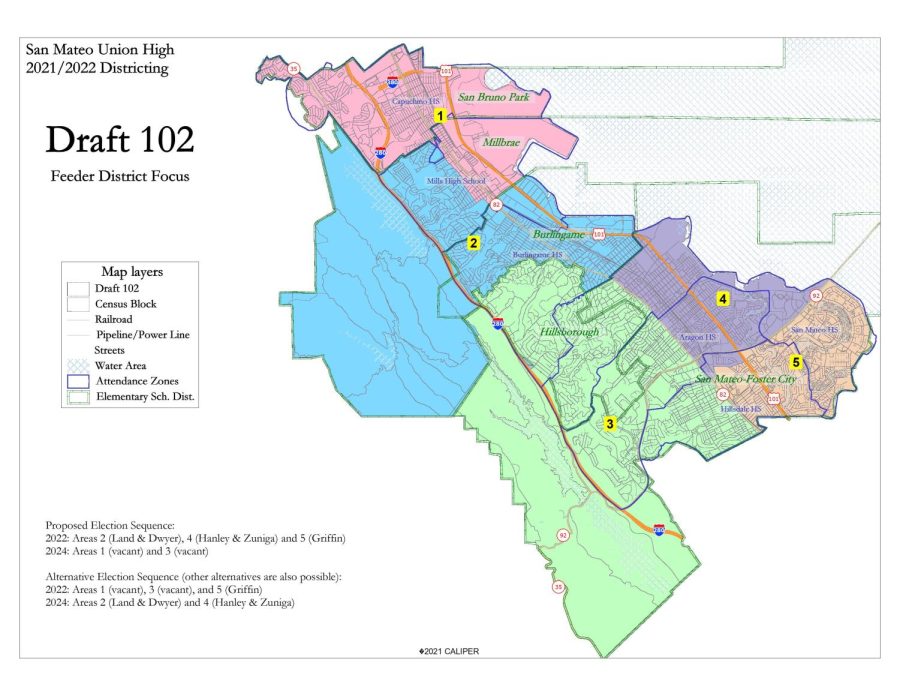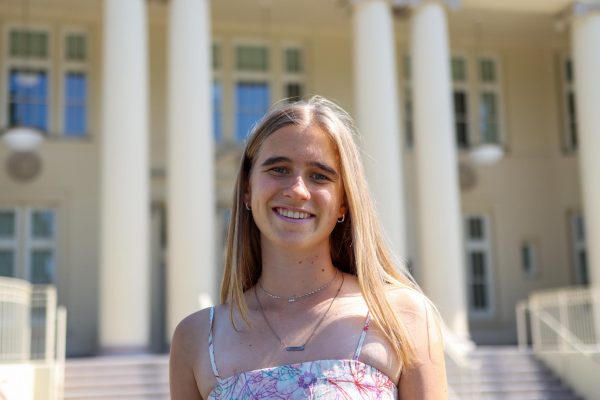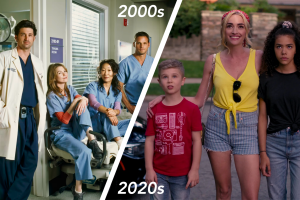Board hears update on student performance, weighs redistricting maps at recent meeting
Image courtesy of San Mateo Union High School District
Draft 102 divides the map according to feeder school districts in an attempt to keep neighborhoods grouped together.
February 20, 2022
Yancy Hawkins, the San Mateo Union High School District (SMUHSD) Chief Business Officer, presented extensive data on the results of the Panoramic survey and other metrics to gauge student performance at the Feb. 10 SMUHSD Board of Trustees meeting.
The presentation attempted to quantify progress in the district’s established goals to make learning and coursework more relevant to student identities, experiences and interests.
Hawkins also shed light on the correlation between consistent attendance and performance in the classroom, with data to prove that an average of 94% of present and engaged students in the district passed their classes, while just 72.6% of chronically absent students did so.
Students qualify as chronically absent if they miss nine or more instructional days, which equates to approximately 54 or more class periods missed. However, school during a pandemic — and especially during the spike of the Omicron variant — made chronic absenteeism a less accurate indicator of student success, given that students with the virus often had to quarantine for 10 days or more. Latino students are almost two times as likely to be chronically absent than their white peers, while 22% of Pacific Islander students are chronically absent — more than three times the 7% of white students. On the opposite end of the scale, just 2% of Asian students were found to be chronically absent.
Many Board members noted the meager number of students (less than half) who feel that their learning is relevant to their lives. This was the first time that question was asked in a Panoramic survey, Hawkins said, and the result proved that there is more work to be done in the classroom.
“I think that’s really critical,” said Trustee Robert Griffin. “If they don’t think it’s going to do them any good, they’re not going to pay attention. You’ve got to get them engaged.”
Trustee Greg Land wondered if the relevance of a subject could impact the pass/fail ratio in those classes. He noted that chronically absent students have a much higher pass rate (86.8%) in Career Technical Education classes than in mathematics classes (63.6%).
“One of the biggest issues is that relevancy: ‘Why is it relevant to me?’” Land said. “Well, career technology, there is an investment there of chronically absent, versus mathematics, which is, ‘I don’t understand why I need to do this. I’m not going to need this.’”
Hawkins also presented data from the voluntary spring 2021 SAT. Of the 169 Burlingame students who took the test, the average cumulative score was 1253. This is 202 points higher than the Class of 2021’s national average, 1051.
By-trustee elections update:
The meeting concluded with a lengthy discussion on potential redistricting maps for the transition from at-large to by-trustee elections.
In January of last year, a Malibu-based litigation firm threatened to sue the SMUHSD for violating the California Voting Rights Act (CVRA). The CVRA protects minority voters from at-large election systems that suppress their power at the ballot box. In response, the district began the process of dividing its jurisdiction for each trustee, a process to be completed by the November 2022 election cycle.
The Board meeting on Feb. 10 gave members their last chance to review and comment on the draft maps before one is approved on Feb. 24.
Douglas Johnson, the president of the National Redistricting Corporation, presented five different maps for the Board members to consider. Each offered a varied approach to balancing population, maximizing minority representation and keeping neighborhoods together.
After public comment from Amy Johnstone, a parent in the district, and Jennifer Wei, a teacher at Aragon High School, the trustees found themselves in agreement that Draft 102 was the best proposal.
Trustee Linda Lees Dwyer felt that Draft 102 did the best job of grouping communities together by arranging districts in accordance with feeder elementary and middle schools,
Johnstone advocated for Draft 102 as well. She proposed that 102 provided concentrated voting power to less-educated and lower-income families, rather than giving undue influence to the educated and the wealthy, making it the ideal map.
The Board members were also in agreement about their main concern: input and engagement from constituents was extremely low throughout the process, despite extensive outreach from Laura Chalkley, the district communications manager.
“We have this very important discussion,” Land said. “And we have about nine attendees at this point. And it’s a shame, because we want to have more input than this. So I am concerned.”
In a last-ditch effort to get the public involved, the district held a public hearing on Feb. 17. Board members presented Draft 102 as the Board’s tentative first-choice and Drafts 103 and 103b as the two other alternatives. Two public speakers offered input on the maps, and both endorsed 102.
Final voting will take place on Feb. 24, adn Board President Peter Hanley emphasized the tight timeline of the project. A map must be chosen by the Board, no matter how much feedback they receive from the public, in time for the county and the election office to process and implement the map by April.
“At the end of the day, they do or they don’t. At the end of the day, we’ve got a timeline, and we’ve got to make a decision,” Hanley said. “And we need to move forward on this.”










































